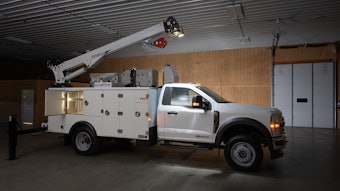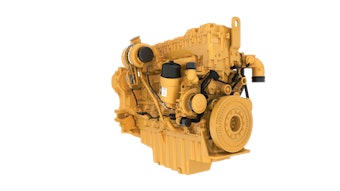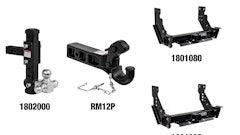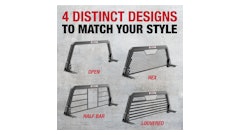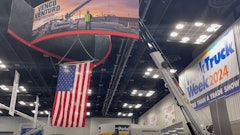Operating a truck off-road takes a whole different skill set than running down a paved road. Such skills can have a substantial influence on vehicle performance.
"Definitely, driver skill has an impact on the uptime of the truck," says Melissa Gauger, vocational marketing manager, International Trucks. "With the varied terrain, mud/sand conditions and high center of gravity loads, operating on/off-highway can be more challenging for the driver. An inexperienced or unskilled driver could potentially damage the truck's drivetrain. Our trucks are designed to operate in on/off-highway environments, but the skill of the driver may impact how much stress is placed on the components."
There is no substitute for experience. "Some drivers, such as dump truck drivers, might have more experience in certain conditions (i.e., off road) and would know the best traction aids and devices to employ, such as locking the rear axles," says Ivan Neblett, vocational product manager, Freightliner Trucks. "In some applications, the driver might be trained to do a specific job and is not necessarily a trained driver, so the driving skills might not be as developed."
He continues, "Overall, the application of the locks, clutch, transmission gears and horsepower depends on road conditions. Know when to use the differential and axle locks on the vehicle. Use a judicious application of the clutch so the engine power will be smooth and steady. Select a higher gear to not over apply the torque."
Monitor underfoot conditions
When operated off road, trucks are subjected to several hazards. "Commonly damaged components include the bumper, driveline, rear axle and rear suspension components," says Neblett. "In off-road conditions, where it is sometimes slippery, vehicles can spin out their rear axles, where tires lose traction and the axle is spinning at more torque than it can handle, which can also damage the rear axle and driveline."
Driveline shock is a common problem. "Twisted drivelines are often seen in spinouts where the tube is twisted around," says Neblett. Damage can occur to the axle pinion gears, rear axle bearings, u-joints, pinion gears and differential gears.
Soft underfoot conditions require special attention. "It's not the road conditions, but how the driver applies the torque in those conditions," says Neblett. "If you apply too much torque, it can result in a spinout."
"Be sure to use power dividers and differential locks when appropriate," says Curtis Dorwart, vocational marketing product manager, Mack Trucks. "Not only can they help you negotiate soft conditions, they can help save the driveline. Excessive spinning of the tires can cause differential and power divider wear."
Muddy jobsites should also be approached with caution. "There is the potential for shock loading of the driveline in a situation where an isolated slick spot is surrounded by good firm traction," says Dorwart. "If you get your wheels spinning really fast and then suddenly the tire gets traction, the resulting shock can hurt your driveline."
"As with soft underfoot conditions, it's more about how the driver applies the torque," says Neblett. "Steps drivers can take to minimize wear and tear include knowing how and when to properly apply the clutch, engine power, throttle and axle locks."
It's also important to choose your path. "Tires and issues related to ground clearance are good for instances," says Dorwart. "Many times, the tire sidewalls are victims of a poorly negotiated route. Once the sidewall is compromised by rocks, metal or other debris, the tire is pretty much junk. A stray stump or other hazard can rip into fuel tanks, catch an unsupported fuel or air hose or even knock out an axle."
"Know the terrain as best as possible, and know how to operate the equipment properly," he advises. "Watch your speed, especially on poorly maintained haul roads. Going too fast can really hammer cabs and suspensions."
Also pay attention to proper maintenance. "Trucks that never leave the jobsite have to be serviced and repaired on site. This puts a big burden on the service techs," says Dorwart. "As a result, sometimes things don't get looked after as well as they should. Little problems like a loose hood hinge bolt can manifest itself into a broken hood in a few days as things loosen up and as the truck hammers down a haul road."
Start drivers on the right path
Of course, not everyone with a CDL is ready to navigate a construction jobsite. "A CDL provides a driver with the basics of truck operation, but there is no substitute for real-world driving experience in a wide range of on/off-highway conditions," says Gauger.
"The best training is more experiential," agrees Neblett. "Experienced construction site drivers can show a new driver the ropes to help them learn how to tackle these environments."
In addition, there are CDL training schools that offer an introduction to on/off-road truck operation. Two such schools, both based in the state of Washington, include West Coast Training and Commercial Driver Services.
There is an ongoing trend toward heavy equipment operators obtaining their CDLs so they can perform multiple jobsite tasks. They not only operate heavy equipment; they transport it to the site with a heavy-haul truck and run the dump truck when necessary. This is where West Coast Training enters the picture. "Our primary mission here is to prepare people to enter the construction industry," says Jeff Woolever. "There is a bias toward construction in our CDL course. Most of our CDL graduates have had formal training and certification in heavy equipment or mobile cranes. It gives them an advantage."
The CDL course is 160 hours, and students must be in possession of a permit before the class begins, which maximizes productive training time. "We start them out in dump trucks and water trucks," says Woolever. "We start them out driving the perimeter road to learn their shifting, which is in sand and clay."
Then they transition into a tractor-trailer on the road. Road trucks include a single-screw Kenworth and a couple of Freightliner twin screws. "They are not designed for off road," says Woolever. "We have them going over dirt and they will find out how easy it is to get those trucks stuck. All those air ride suspensions need is a little bit of uneven ground and they spin out. The dirt roads are a mixture of clay, loam and sand. It is easy to sink a truck in. It is challenging."
But this is necessary experience. "Even if they are driving a boom truck and they are delivering trusses to the jobsite, they are going to have to be operating in the dirt," Woolever points out. "They learn some of the tricks on how not to get stuck or to get unstuck without making the problem worse."
During the training, the drivers will also load and unload equipment on a lowboy. "They actually drive a dozer, an excavator and a backhoe up onto the trailer during the course and chain it down," says Woolever. "That is different than your typical CDL course."
Closer to the end of the program, students go back to the field with the dump trucks, which are set up with off-road capable walking beam suspensions. They load them, back them up and dump or spread material. In addition, West Coast Training offers a mobile crane course, which adds yet another capability for future construction drivers.
Specialized dump program
For drivers who primarily want exposure to dump truck operation, Commercial Driver Services offers a specialized class in addition to its CDL training.
"We send all of our students through our Class A program first," says Lee Brunk, president. "It is a 160-hour program." Drivers can then opt for the 20-hour dump truck program. "It is a basic introductory program to the off-road industry. Our Dump Truck program is four hours of classroom followed by two full days of training in the field."
Drivers operate a four-axle dump truck and three-axle pup with extended tongue and a 100,000-lb. GVW. "We haul loads, do stockpiling and home delivery. We travel to various pits to teach proper etiquette," says Brunk. "There is nothing more embarrassing than going into a pit where several experienced drivers are trying to get loaded and get out of there while you are in the middle of the yard asking questions."
Students are also taught how to enter pits and what safety hazards to look for, and the scaling process to ensure proper weight distribution. Instructors also demonstrate how to jack back over the tongue with a loaded truck/trailer to empty units without unhooking the trailer from the dump truck.
Dump trucks can be inherently unstable on uneven ground and even on soft spots on level ground. Commercial Driver Services emphasizes G.O.A.L -- Get Out And Look. "Get out and investigate the soil, the ground before you back in there and raise the bed," emphasizes Brunk. Students are also instructed in how to spread gravel by setting the chains on tailgates, and in proper speed control.
"Learning the processes, procedures and safety is probably the biggest difference for dump truck operators," says Brunk. "You need to make sure the right switch is flipped when you need to flip it, and how to safely operate on uneven soil or unsettled ground without getting stuck or causing damage to the equipment."
While limited to 20 hours of classroom and field training, operators can get a good feel for the basics of operating a dump truck. "We haul between six and a dozen loads a day," notes Brunk. That is 20 to 24 loads to physically back up and empty both the truck and pup. "You will gain knowledge on how to operate the extended tongue while operating a loaded trailer. So all of the controls of the vehicle are taught and illustrated to ensure all of the processes are followed, giving the student driver the insight to safely operate the vehicle."
This type of training is becoming more important as equipment operators continue to expand job duties with a CDL. "It used to be that you had an operator for the bulldozer and an operator for the truck to bring the dozer to the jobsite," recalls Brunk. "But now the dozer operator is the CDL operator, allowing one person to do both tasks."

